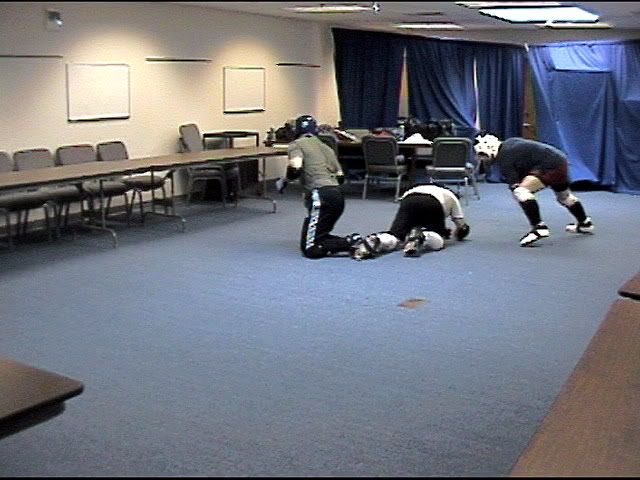The popularity of BJJ and MMA has also introduced the general public, and even some martial artists, to the idea of submissions. Per the Wikipedia entry, "A submission (depending on the context also referred to as a "tap out" or "tapping out") is a combat sports term for yielding to the opponent, and hence resulting in an immediate defeat. The submission is commonly performed by clearly tapping the floor or the opponent with the hand or sometimes with the foot, to signal the opponent and possibly the referee of the submission. The submission can also be verbal, during which the fighter verbally informs that he is giving up. In some combative sports where the fighter has cornermen, the corner can also stop the fight by "throwing in the towel", which may count as a submission."
Queries:
- Are "submissions" appropriate for self-defense?
- What happens if someone won't submit?
- What are the best submission techniques for self-defense, if appropriate at all?
Let's examine:
Small joint manipulations are basically digital submissions, which doesn't mean sending a PDF file via email! By "digital," I mean that you apply a finger or toe lock (the digits) on someone so that they give up. These techniques may cause your opponent to submit due to the pain.
Issues:
If they don't respond to pain, or are hyper-flexible ("double-jointed"), you could be in a world of trouble because your lock is ineffective, and you've lost the initiative. You may be focused on the lock, expecting the subject to submit, and he/she is not only unphased, but knows something sooner than you - they are still effective in the fight. Not good.
Escalation:  Depending on the type of lock, you can proceed to break the finger or toe, or cause other damage which may reduce the effectiveness of your opponent. Or not.
Depending on the type of lock, you can proceed to break the finger or toe, or cause other damage which may reduce the effectiveness of your opponent. Or not.
Progressing up the chain, wrist and ankle locks are twisting and turning those joints in a direction they aren't meant to twist or turn, or further than they are intended to go. Either way, they can hurt, or fail for the reasons suggested above.
Elbow and knee bars usually cause less pain, but, I feel are more serious, at least when they are applied to me. They're scarier. I hate the feeling of knowing that if I don't submit to a knee bar or leg lock that I may not be walking right for the rest of my life. The arm bar is the same way. I submit out of fear of injury.
Arm locks are applied to the shoulder joint, and include techniques named things like arm lock, Kimura, Americana, Omo  Plata, etc.
Plata, etc.
Finally, we get to chokes - including the guillotine, front choke, side chokes, rear choke, chokes utilizing the body only (naked chokes, which can actually be performed with clothes on - I've tried it), and chokes using the clothing you or your victim are wearing. We further break the choke down into "blood" chokes, in which the arteries to the brain are constricted, causing loss of consciousness, and "air" chokes.which restrict the flow of oxygen to the same brain.
Conclusions:
- Are "submissions" appropriate for self-defense? Depends. If you know a submission, whether it's a small-joint or arm lock, you must be prepared for the subject to be non-compliant or insensitive to the pain of the manipulation, or just too strong for you to lock it in properly. The other consideration is weapons and multiple opponents. In every case where we've sparred with multiple opponents, including grappling, once you tie yourself up by touching or grappling with an opponent, you will probably be taken down and stomped, unless you are so far superior that you can handle anyone at any range. If weapons are involved, and you never know whether they are until it's too late, then you don't want to try a submission.

- What happens if someone won't submit? You can be in a world of hurt if you tie up one or both hands with trying to submit someone. If you are a BJJ black belt or superior wrestler, you may be in your element, but there's always someone better, as they say. You always need a "plan B," and in a self-defense situation, that means escalating the force (i.e. breaking the joint to disable it, or moving up to a choke), or breaking off if possible. This also means you may need to depend more on your footwork and striking, which have more potential for criminal or civil liability.
- What are the best submission techniques for self-defense, if appropriate at all? I'd have to say that they can all work, at the right time, but if you are skilled in choking, that's as sure a fight stopper as there is. Many of us could fight with a dislocated joint or even broken bone, but absolutely no one can go with no oxygen going to the brain!
Final note: Submissions are absolutely appropriate where you have to control the use of force (law enforcement, security, and corrections officers), or where you have superior numbers. Gang-tackling and superior positioning plus skilled submissions means less people get hurt. Unfortunately, many of us don't have a posse with us, so use discretion and don't get trapped into trying submissions when they aren't appropriate!
Stay safe - Nathan

1 comment:
Another thing you can concider is go through senerios in your head, and impravise. My cousins and I like to get together and spar. I have no formal training at all, but Just form geting my guts kicked in enough times, I've come to find out that when impraviseing submitions, assumeing it's a 1 on 1 fight, locking your own joints when in position is makes it twice as hard for the other person to brake loose. This works especially well with chokes. My personal favorite choke is puting the left handon your right shoulder with your fingertips just above your shoulderblade. Then takeing your right hand around there neck under your left fore arm right in the bend of your left elbow, then over your upper arm with your palm on your left bicep, and your fingers around your tricep. If positioned corectly, there adam's apple shoule be in the center of the inside of your right elbow, then all you have to do is tighten all your arm muscles at once like a boa constricter. I like this choke the best, because not only is it extreemly hard to get out of, because your hands act like ancors, but it is both a "blood" and "air" choke. I am 6' tall, and 155 lbs. and i've brought down guys twice my size with this for the simple fact it cuts everything off.
- Nick
Post a Comment